PowerMac G5 Coolant Leak Repair/Overhaul
By Bill S.
Posted: Oct. 8th, 2009
Revised Oct. 21st, 2009 for P/Ns on O-Rings, etc.
Revised again w/notes still leak-free as of Nov. 2010.
Added notes/links on O-Ring Matl.
FYI/Update (July 22, 2010): Expanding on this original article, Bill sent a 6 page Guide to Overhauling a PowerMac G5 Delphi Liquid Cooling System.
(Due to the length/photos, etc. I posted this leak/repair report on a separate page rather than the original PowerMac G5 Coolant Leaks/Repairs page which has already grown to over 340KB due to so many reports since posting in Aug 2007.
Since Bill didn't cover the initial take-apart, so here's a link to ifixit's G5 Take Apart guide which has photos (appears like those from the G5 service manual PDF) on removing the heatsinks and CPU module.-Mike)
Reporting (per your request) on the recent LCS overhaul on my Early 2005 2.7GHz GHz Dual CPU PPC PowerMac. Unlike other articles I have read on the leaking coolant problem with LCS G5s, I had no indication of overheating. That is, Hardware Monitor (there's also a freeware Temperature Monitor from the same author) reported temperatures of 53°C - 56°C on both CPU A and B.
(BTW - as noted in many (most) of the reports here on the PM G5 Coolant Leaks/Repairs page over the last 2 years, most did not monitor temps or check for leaks until major problems (shutdowns, failures to boot, etc.) and/or damage had occurred - in some cases requiring a new motherboard, CPUs and power supply. (IIRC one report mentioned apple even replacing the main case.) Some had run for many months with a leak - for example one report from Oct. 2007 included a link to photos of major corrosion/damage (at rknochenmuss.ch/G5leak/G5.html) from a pump o-ring leak. (Take a look at the rust on the bottom of his Power Supply.) For about 2 years I've included a note (in red) on that page to check for leaks frequently.-Mike)
Nevertheless, my computer would refuse to boot once it had been running for 10 - 15 minutes, until I shut it down for about an hour. Once booted, I could run it all day with no apparent problems. The computer was a gift from my wife in December 2005, and the computer was built the week of May 14, 2005.
After reading several articles on the Net about leaking O-rings, I overhauled my LCS in September of 2009. After pulling the CPU/LCS assembly, I took photos as I went along. I removed the CPU boards from the LCS, cleaned off the white "rice," cleaned the two heat transfer modules, flushed the radiator and aluminum tubes, replaced all of the flexible coolant lines with 3/8" fuel line, replaced the coolant, replaced the O-rings, applied thermal grease, and re-installed the CPU boards on to the LCS. The following pics document what I did better than any text, I think.
1) A view into the top of the CPU board and bottom of the LCS showing the white granular contaminant:
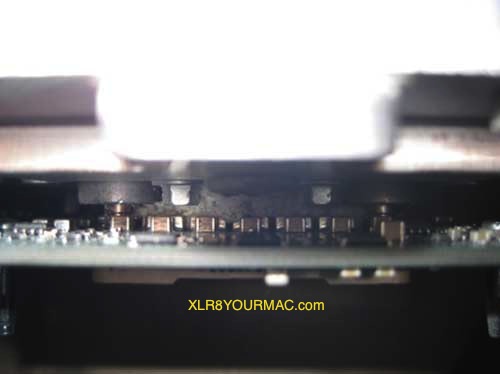
2) Contamination of the top of the CPU B board:
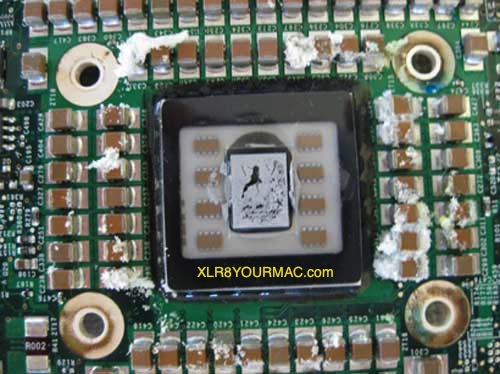
3) Closeup of CPU B board after cleaning first with vacuum, then with acid brush and alcohol, using Xacto knife in places:
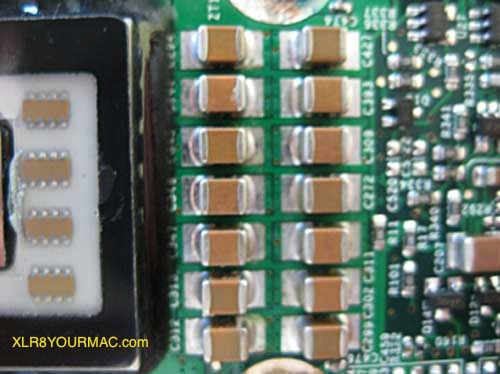
4) O-ring leakage products on the heat transfer modules:
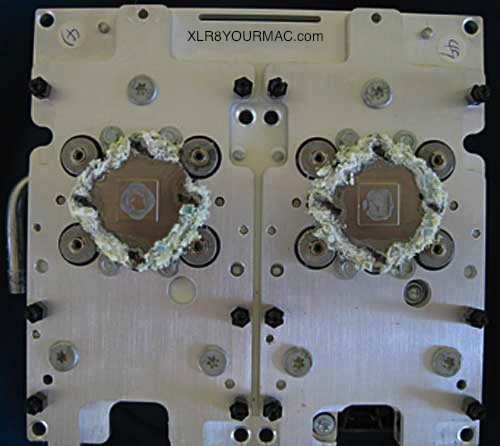
5) Interior of a leaking heat transfer module, showing the finned mini-heatsink:
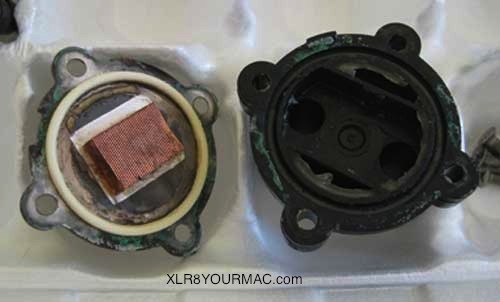
6) New Viton O-ring on a cleaned heat transfer module cap (O-ring is later installed in mating housing's groove):
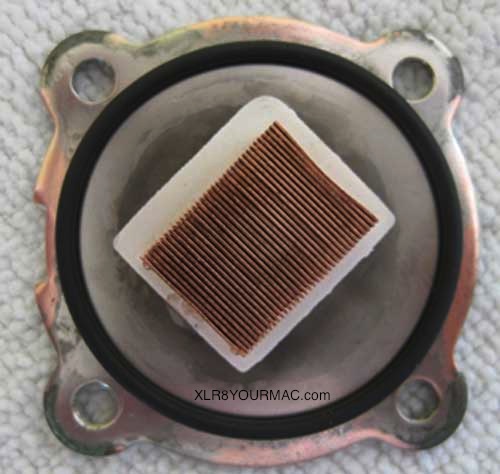
7) Heat transfer modules cleaned and reinstalled:
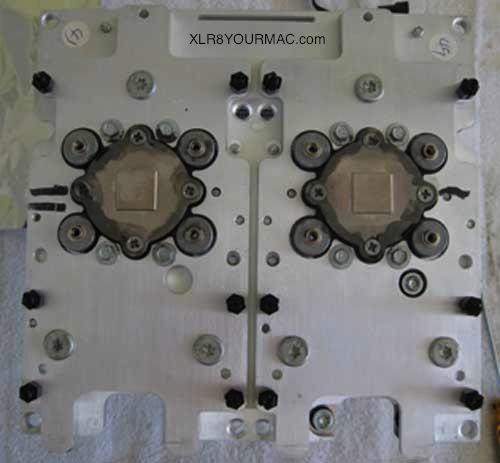
8) CPU A reinstalled, thermal grease on heat transfer module B:
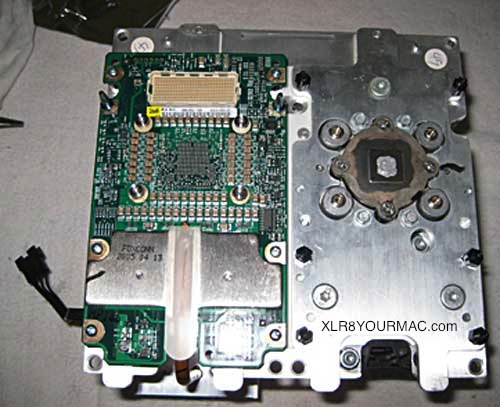
9) LCS (no CPU boards installed) after overhauling:
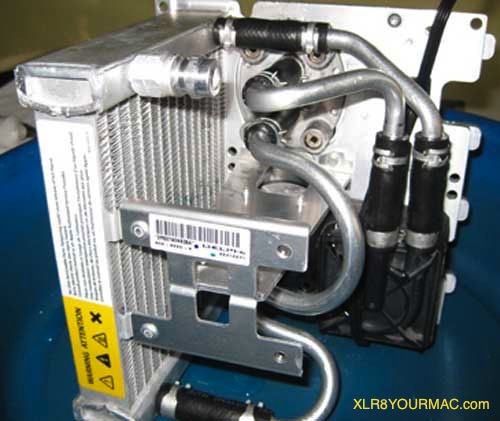
I thought it odd that the input of the coolant pump was the output of the second heat transfer module, and that the output of the pump (see arrow on the pump in the picture above) went to the bottom of the radiator. I would have expected the system to pump cooled liquid to the heat transfer modules and the hot coolant to be returned to the top of the radiator, as in an automobile cooling system. That could easily have been reversed with slight bend adjustments to the aluminum tubing at the pump's input and output, but I left it as it was. (Advantage of reversing would be the pump operating in the coolest possible environment rather than the hottest.)
(he later wrote)
I was indeed lucky that I had no further damage (as in your included link of the corrosion problem). I didn't mention in my e-mail that I had also disassembled the coolant pump and checked its condition, which was fine. Maybe you could recommend some reasonable interval for checking the LCS as preventive maintenance. (For almost 2 years now, in red text on the original Leaks page first posted in Aug 2007 here I've suggested periodically checking for leaks (personally I'd do it once a week or so) - and as mentioned there (again in red text) - I'd do the "side cover off/open side face down" suggestion (overnight if possible) as often leaks may not be visible from just cursory looks inside. Most users I doubt would be willing to remove the LCS from the case for inspection.-Mike)
The view as in my first pic between the CPU and LCS can be seen once the CPU/LCS assembly is pulled from the G5 chassis. It does not involve separating the CPUs from the LCS, so that would be an easy check of the O-rings. In that condition the coolant pump and lines could also be looked at for possible tracks of coolant.
Mine went 4-1/2 years getting to the pictured state, but obviously I don't want that to happen again. The label on the coolant I used carries "Effective Duration - 2 years," so I would think that establishes an absolute maximum time between flushes and refills. (The coolant I used was recommended by Paul Kopetka on the Apple Discussion Forums. It is Cooler Master "Aquagate NC-1;" I bought it from NewEgg, along with a thermal grease.)
I really want to keep my G5 and Tiger running as long as possible, since it is the last Mac that will run Classic, and I spend time with my old video games as well as with newer ones.
(a later update)
Decided to check my LCS this morning for any possible leakage since my overhaul. Happy to say it's dry as a bone. (Bill sent a later inspection report on Nov. 10th, 2010 that noted it's still leak-free.) I discovered that it is NOT necessary to pull the CPU assembly to do a thorough leak inspection. I found that using a bright, small flashlight, and putting its lens up against the computer's front grille next to the USB port, I could look through the grille and see into the area between the CPU board and the two heat transfer module surfaces of the LCS. Essentially one can see the same interface area as in my first picture, and if there is "white rice" in there, it should be obvious. I do think that viewing that interface is a very important part of the inspection. (Of course, just removing the G5 heat shield allows inspection of the radiator, pipes, hoses, and coolant pump.)
Materials used for the Dual 2.7GHz LCS repair:
(Note: O-Rings listed below are for the 2.7GHz Delphi LCS. If you have a different series/LCS model - verify (measure) your original o-rings before buying replacements.-Mike)
I ordered the O-rings from MSC Industrial Supply Co: a package of 50 Viton O-rings identified as "Viton AS568A Aerospace Standard ID Number: 027". Dimensions: ID = 1.313", OD = 1.438", thickness = 1/16", price $12.12.
(FYI on O-Ring Materials:
I don't know the exact type of Viton the O-Ring's from MCS are but a Wiki page on Viton lists one of the Viton family types ("F" - Terpolymers of VF2/HFP/TFE) as used for "Oxygenated Automotive fuels. Concentrated aqueous inorganic acids, water, steam." (emphasis mine, and granted Wiki pages are not always 100% accurate). A reader however sent a note that per www.aceseal.com/common_materials.html and www.marcorubber.com/materialguide.htm, although rated to 400°F (higher than Ethylene-Propylene), they list Viton (V/FKM on the former link, Type A on the latter) as not recommended for use with hot water and steam applications. Aceseal.com's page lists Ethylene-Propylene (EP, EPR, EPDM) for hot water/steam applications. (The Coolant additive raises the boiling point of the water of course but I think the reader was concerned those sites didn't list Viton for hot water applications.)
Regardless, Bill has noted the Viton o-rings he bought have not leaked after over a year of use. He was forwarded a copy of the reader's mail/links and may reply to this with specifics/data sheet info on the o-rings he bought. I've not done more digging into this personally than I've listed here.-Mike)
Update: Here's Bill's reply to the question about Viton use for this application:
My previous experience with Viton vacuum hoses and O-rings led me to choose that material. I had not seen the charts (on the links above), but have seen others like this one at www.rainbowrubber.com/VB.pdf. (Viton info PDF), Scrolling down to Table 2, Viton has a rating (by Dupont) of "1" (best) for water both above and below 80°C. Also in the text immediately following the table is this paragraph:
"Viton retains sealing force to prevent leaks even after compression for long periods in severe environments.
After 100 hours in air at 150°C (302°F), Viton retains more than 90% of its original sealing force, while seals of fluorosilicone, polyacrylate and nitrile retain only 70%, 58% and 40%, respectively."
IMHO the most important parameter for the O-rings in the Delphi LCS is retention of sealing force over long periods; Viton is outstanding in this respect. As to water temperature, the "Hardware Monitor" application on my G5 never reports higher than 90°C at the CPU chips, so although Viton may not be the right choice at, say, 100°C or higher (given an ethylene glycol mixture which raises boiling point), the material itself is rated for continuous use at extremely high ambient temperatures (see "150°C" in the paragraph above, and 204°C in Table 2).
I'm no expert on the comparative properties of the various materials. I do know that the white O-rings supplied by Delphi with my G5 leaked; I do not know what material they were made of. I also know that having checked for leaks recently (a month or so ago), I see no indication of wet surfaces anywhere in the LCS or at the O-ring interfaces. So my Viton O-rings have lasted 15 months so far with no problems. EPDM might very well work just fine; I have no experience with anything other than the OEM O-rings (bad) and Viton (good so far).
There is more information on Viton available by searching Google; www.pspglobal.com/polyethylene.html is one more source. And yet another at www.pspglobal.com/nfvitongrades.html (table) shows the variations in properties among different versions of Viton.
-Bill
The thermal grease ordered from Newegg was "Masscool G751 Shin-Etsu Thermal Interface Material," Newegg item number N82E16835150080, $2.99.
The coolant was "Cooler Master RL-ACL-NNUB-GP Water Cooler," Newegg item number N82E16835103048, $11.99.
The 9" long 2.5 mm hex driver from Rutland Tool & Supply Co. was their item number 23322832, "2.5 mm, 9" arm, C/GRP T-Handle Hex Key USA," price $2.51. (This was not an online purchase.) (ACE hardware, Sears, etc. often have tools like this also.)
Incidentally, FWIW, I have observed that "Hardware Monitor" shows around 51 - 53°C in normal use, but can peak quickly to 80 - 83°C during video streaming while in Safari. Temp comes down as quickly as it rises when streaming quits. 88°C is displayed "maximum allowed" temperature for the CPUs. The Memory Controller temperature (not liquid cooled) also goes to 83°C under the same streaming condition; normally it runs about 74°C.)
-Bill S.
|